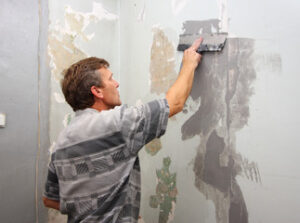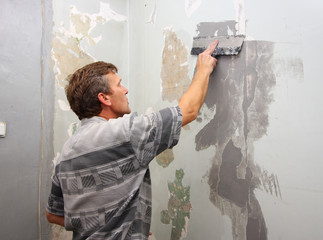Stucco Repair Philadelphia is the fixing of surface-level damage, such as chips and cracks. It’s important to speak with a stucco professional so they can identify the root cause and recommend remediation if necessary.
Gaps around windows, doors, and other openings indicate moisture penetration into the wall, which can lead to mold growth, moss, wood rot, and structural problems. Remediation involves replastering the walls to address the underlying issue.
Hairline cracks that appear on a stucco wall are usually not a major concern, but they can be repaired easily with waterproof caulking. However, larger cracks can point to more serious issues with the foundation or water damage and should be addressed by a professional stucco repair company that offers comprehensive services.
Regardless of the severity of a crack, it is important to address it immediately to prevent precipitation from seeping behind the stucco and damaging the home’s structure. To begin, the homeowner should clean out the crack and surrounding area to remove any dirt and debris that has accumulated. This step will also help ensure that the waterproof caulk or patch will adhere properly and will not come undone in the future.
Once the crack has been cleaned, a layer of waterproof caulking should be applied along the entire length of the crack using a standard caulking gun. The caulk should be troweled to match the texture of the surrounding stucco, ensuring a smooth transition. Once the caulking is dry, the homeowner can cover it with water-based paint, preferably in the same color as the home’s exterior.
For a more permanent solution, a special waterproof compound can be used to repair stucco cracks. These products are typically available through a stucco supplier, and they are prepared by mixing one part of a liquid concentrate with two parts water. The product will then form a tan emulsion that can be applied to the cracked areas of the stucco.
Homeowners can choose to apply the damp concrete primer with a brush or roller, but a narrow brush is best to avoid any unnecessary mess. Once the liquid is applied, it will soak into the small, medium, and large pores of the stucco or concrete and create a waterproof barrier that will protect the structure for years to come. Alternatively, a conventional stucco repair mix may be used to remedy larger gouges and holes, but this mixture should not be used for hairline cracks as it is not sufficiently durable.
Repairing Holes
Stucco is a versatile material that can be used for many different projects, including home siding. If you’re interested in using stucco for your next home project, it is important to be aware of common problems that can occur with the material and how to fix them. These issues can range from minor cracks to major holes in the stucco. When addressing holes, you should always hire a professional contractor to help. However, with a bit of knowledge, you can save yourself some money by completing the repair yourself.
When addressing small to medium-sized holes, you can often use a pre-mixed stucco patch that is available at most hardware stores. This product can be used to fill in holes, spalls, and breaks in stucco walls up to one-quarter inch wide. The patch is a convenient option because it requires no mixing and dries to a durable finish that matches the texture of the surrounding stucco.
For larger holes, you will need to follow a slightly more complicated process. First, you will need to remove any broken pieces of stucco. If there is a lot of broken stucco, you may need to chip it away with a hammer and chisel. Once you have removed the damaged stucco, you will need to clean the area with a wire brush and blow away any dust. You should also be sure to wear protective work gloves and safety glasses.
Once you have cleaned the area, you will need to apply a base coat to the wall to prepare it for the stucco patch. The base coat will also need to dry completely before you can start working on the hole. Next, you will need to add a second layer of stucco. Once again, you will need to make sure that the second layer of patch is pressed firmly into place and that it fills the hole.
Depending on how large the hole is, you may need to add a third and final layer of stucco. Once you have completed the patch, you will need to sand it down and paint it a color that matches the rest of the wall.
Remediating Cracks
Many homeowners find themselves with hairline cracks in their stucco. Unlike larger structural cracks, these surface-level cracks are not serious and can be easily repaired. In order to repair these cracks, it is important to determine the degree of damage. If the cracks are only in the plaster, then it is possible to use a concrete patching mix and a float to fill them and even them out with the surrounding, undamaged area. Once the new plaster dries, it can then be painted to match the color of the rest of the stucco.
If the cracks are deeper into the stucco, a more extensive process is needed to fix them. This process is called remediation. Remediation is a much more involved project and should be left to professionals. If the cracks are in the sheathing or framing, it is necessary to replace the water-damaged sheathing and framing material. This can also include the replacement of insulation and drywall. In some cases, this can be a much more costly process, but it is essential to the long-term integrity of your home.
The first step in repairing these deeper cracks is to remove the cracked stucco and any debris from the damaged area. It is also a good idea to remove any wood lath material that is still attached. Once this is done, it is important to clean the area and use a damp sponge to wipe away any loose dirt or dust that may be present. This will help ensure that the new plaster will bond well with the existing material.
Once the cleaned area is dry, it is important to use sanded caulk to fill in any gaps that are present. This is best done in the morning, when a house will be cooler, and this will help prevent the cracks from widening later on.
It is also a good idea to use a paint or fog coat that matches the texture of your stucco. This will help the repaired area blend in and look more natural. Lastly, it is a good idea to have the property inspected on a regular basis by a professional. This can be done by using a moisture meter, a borescope, and other non-invasive tools.
Remediating Holes
Small cracks and holes in stucco are a common occurrence that is often easily remedied. This type of damage is typically caused by outside forces such as wind or water and is a surface-level issue that is easy for most homeowners to tackle without calling in a professional.
For small, thin hairline cracks and holes that measure less than 1/16 of an inch in width, homeowners should use waterproof caulking to fill them. Caulking is an inexpensive and quick fix that can be completed in about a half hour. This repair will be able to accommodate changes in temperature without causing further damage or cracking in the stucco.
If the crack or hole measures larger than this, it will need to be patched with a stucco mix. Using a putty knife or drywall trowel, apply the premixed stucco patching material to the area. For best results, it is recommended that the patching material be applied in multiple layers and allowed to dry between each application. Once the patch is completely dry, it can be painted to match the existing stucco.
To address larger cracks and holes in the stucco, homeowners should first brush or vacuum the crack to remove any dirt or algae. Then, with a cold chisel and hammer, widen the crack up to about 1/4-inch wide and bevel it on both sides. Afterwards, the crack should be smoothed with a sanding tool to prepare it for repair.
Once the damaged areas have been prepared, a new coat of stucco should be applied. A sand-based mix that matches the existing texture is best for this task. For a better finish, a float can be used to smooth the layer and create a uniform appearance. After the stucco is complete, it should be allowed to cure for about a week before it can be painted.
Remediation and repair of stucco can be a time-consuming project, but with the right materials and proper preparation, it is more manageable than some may think. Homeowners should always consult a qualified home inspector or licensed contractor to determine the cause of any water damage or structural framing issues that may be present beneath the surface before attempting any repairs.
